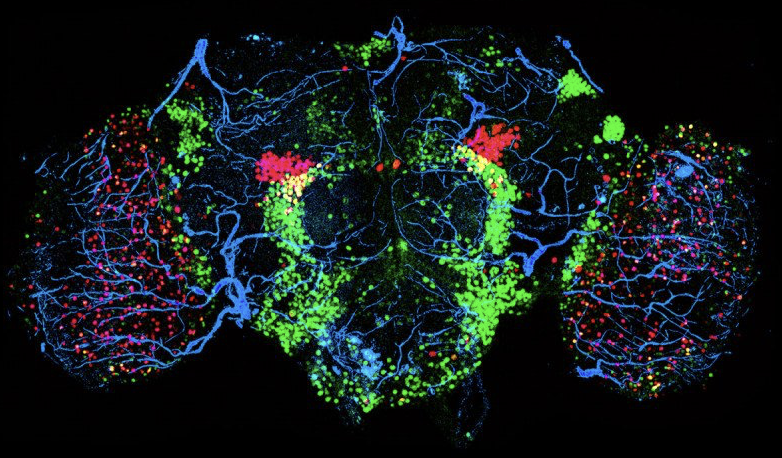Does your dog know when your cat is angry?

- Our voices and facial contortions often betray our emotional response to a situation.
- We’re not alone: Most animals use body language and voice to communicate their emotions to others, strengthening emotional bonds in a group.
- New research shows that domesticated and wild horses and pigs respond to human emotions, and to those of closely related species.
In his seminal work On the Origin of Species, Charles Darwin describes natural selection, a theory that has become the foundation of modern evolutionary biology. But fewer people know his third major work of evolutionary theory, The Expression of the Emotions in Man and Animals. In it, Darwin lays out his case for why emotions, like other traits, adapt and evolve over time.
Though unpopular at first, most scientists now agree with the idea that emotional expression has been conserved across species because emotional intelligence serves a critical role for animals. Animals use emotions to react to events they find significant. When we express emotions, others pay attention. Sometimes our emotions trigger an automatic, subconscious emotional response in the receiver. The researchers describe this effect as “emotional contagion.” Put another way, emotional contagion is the start of basic empathy, the capacity to be affected by and share the emotional state of another. Empathy can amplify emotions within a group, heightening social bonds.
We know that emotional contagion is a powerful force in humans. Research has also shown it occurs in the social lives of dogs, bonobos, mice, and pigs. But whether emotional contagion could occur across species is another question.
Can animals understand each other’s emotions?
Because different species can be very familiar with one another — think of a dog and its owner — it makes sense that we have learned how to perceive and discriminate emotions to facilitate cross-species interactions. Several studies have sought to determine whether non-human animals can interpret vocal or facial emotional cues from humans. This work has given us empirical evidence to back up what all animal owners know — dogs, cats, horses, and even mice can understand and respond to our emotions.
But no study has investigated whether non-human animals can discriminate between emotions in the vocalizations of other species that are not human. So, we know that your dog can tell when you are mad. But can he understand the annoyed meows of your cat? This information matters: Understanding how animals interpret the vocalizations of closely related species is key to understanding cross-species perception of emotions. It also gives us important clues about the evolution of emotional perception. To further this understanding, researchers from the University of Copenhagen and ETH Zurich observed a number of animals: domestic horses, wild horses (specifically, a breed called Przewalski’s horse), domestic pigs, and wild boars. They tested whether these animals could discriminate between the positive and negative emotions of members of their own species, related species, and humans.
Their results showed that all the species except wild boars could distinguish between the positive and negative emotional displays of members of their own species, members of another closely related species, and humans.
The research provides ample evidence to support the cross-species perception of emotions. It also shows that different animals probably learn emotional intelligence in different ways.
If you’re happy and you know it, wag your tail
First, the researchers recorded the sounds of different individuals from each species. Half of the animals were female and half were male, and the sounds were recorded when they were in negative or positive emotional states.
The researchers placed animals in contexts assumed to induce positive and negative emotions. For example, sometimes the animals were reunited or separated with other group members. In other cases, researchers either provided or removed food, water, and toys. The researchers used accepted indicators such as body position, as well as physiological indicators — heart rate, respiration rate, and the like — to confirm whether the animal was feeling pleasant or unpleasant emotions. When the researchers analyzed the recordings, they found that the acoustic structure of vocalizations (whinnies for the horses and grunts for the pigs) differed according to the situation.
For humans, the researchers used voices of actors from a validated database as they expressed joy, amusement, anger, and fear. In these recordings the actors did not use any meaningful phrases or words. This controlled for the possibility that the domestic animals respond to the word, not the emotion.
Researchers exposed the animals to all the positive and negative recordings from members of their own species, closely related species, and humans. So, a domestic pig heard noises from other domestic pigs, as well as from wild pigs and humans. The researchers played back the noises on speakers, ensuring that the latency and time between recordings was equivalent among species. The only features that changed were the speaker and the type of emotion expressed.
Measuring emotional contagion among animals
The researchers measured a series of physical cues to determine how the animals reacted to the sounds. They recorded the animals’ reactions and then used a blind study design — researchers were unaware of the treatment used when they scored the animals’ responses. The observers looked for a suite of responses, including reactions toward the loudspeaker (approaching, looking at, or avoiding the speaker); movements (standing, walking, running, or trotting); head movements (especially ear movements, such as the proportion of time spent with ears perpendicular, oriented backward, or oriented forward); tail movements; and vocalizations.
Domestic and wild horses alike responded more strongly to the playbacks when the vocalizations were negative, compared to when these were positive. They spent more time walking and paid more attention to the speaker. This happened regardless of whether the speaker played back the noises of conspecifics, related species, or humans. Domestic pigs also reacted more strongly to the negative emotions of any species.
Interestingly, wild boars did not respond to the noises of other wild boars, nor to those of humans. However, when the boars heard the vocalizations of negative or positive domestic pig calls, they moved their heads more often, produced more calls, and spent a long time with their tails high and standing.
All species reacted more markedly in all cases to closely related species or to conspecifics, and less markedly to a human voice.
Overall, domestic horses, Przewalski’s horses, and pigs distinguished vocal indicators of positive and negative emotion in all species, but wild boars only responded to domestic pig calls. These results suggest that the emotional responses of horses and pigs may come about by different mechanisms, such as degree of relatedness and domestication.
The foundation of empathy?
In some situations, the animals mirrored the emotions to which they were exposed, especially negative ones. The researchers did not directly test for this type of emotional contagion, which has long been considered the first step toward empathy. Still, their research will likely spur other behavioral biologists to evaluate the emotional intelligence and capacity for empathy of these and other animals.





